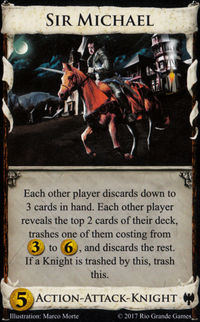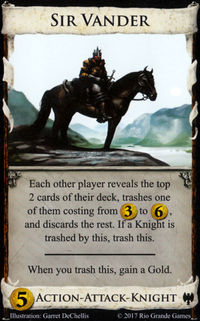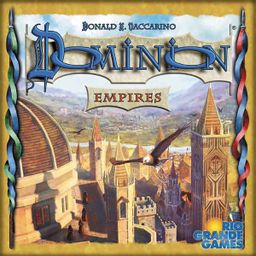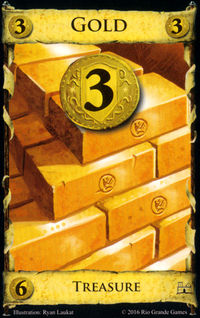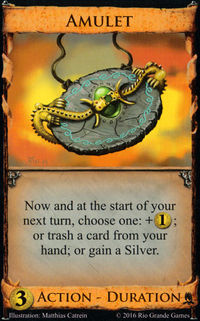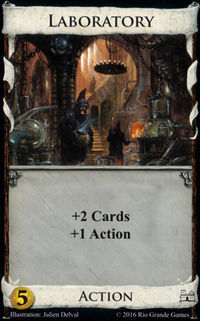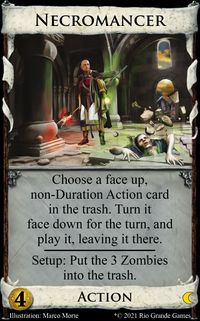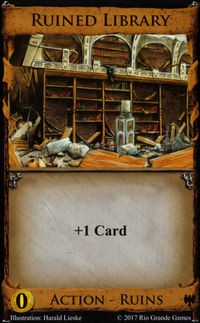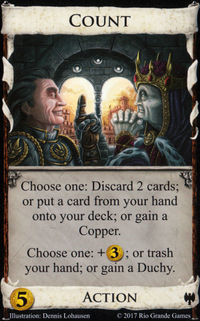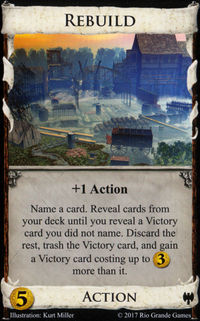Knight
| Knights | |
|---|---|
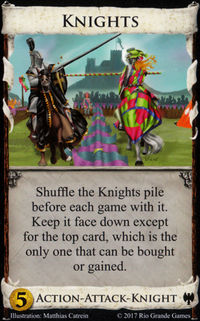 | |
| Info | |
| Cost | |
| Type(s) | Action - Attack - Knight |
| Kingdom card? | Yes |
| Set |
Dark Ages |
| Illustrator(s) | Matthias Catrein |
| Card text | |
| Shuffle the Knights pile before each game with it. Keep it face down except for the top card, which is the only one that can be bought or gained. | |
Knight is a type of Kingdom card from the Dark Ages expansion. There are 10 differently-named unique Knights with a single randomizer card; when Knights are selected as a Kingdom card for a game, they are shuffled into a single supply pile, of which only the top card can be seen and gained at any given time.
Every Knight costs except Sir Martin, who costs .
Every Knight is an Action–Attack–Knight card (Dame Josephine is also a Victory card) with the same main trashing attack ability—''Each other player reveals the top 2 cards of their deck, trashes one of them costing from to , and discards the rest. If a Knight is trashed by this, trash this card"—and each Knight has a unique second ability.
Contents |
List of Knights (and their secondary abilities)
- Dame Anna - You may trash up to 2 cards from your hand.
- Dame Josephine - 2

- Dame Molly - +2 Actions
- Dame Natalie - You may gain a card costing up to .
- Dame Sylvia - +
- Sir Bailey - +1 Card +1 Action
- Sir Destry - +2 Cards
- Sir Martin - +2 Buys
- Sir Michael - Each other player discards down to 3 cards in hand.
- Sir Vander - When you trash this, gain a Gold.
Image Gallery
Additional rules
Preparation
- If the Knights Kingdom card pile is being used, shuffle the Knights before the game, and place the pile face down with the top card face up.
- The pile does not get a token for Trade Route (from Prosperity), even if the top Knight is a Victory card.
FAQ
Official FAQ
- This is a pile in which each card is different.
- There is the same basic ability on each card, but also another ability unique to that card in the pile, and they all have different names.
- Shuffle the Knights pile before playing it, keeping it face down except for the top one, which is the only card that can be gained from the pile. See Additional Rules and Preparation.
- Follow the rules on Knights in order from top to bottom; Sir Michael causes players to discard before it trashes cards.
- The ability they have in common is, each other player reveals the top two cards of their deck, trashes one of them that they choose that costs from to , and discards the rest; then, if a Knight was trashed, you trash the Knight you played that caused this trashing. Resolve this ability in turn order, starting with the player to your left.
- Cards with (from Alchemy) or (from Empires) in the cost do not cost from to .
- The player losing a card only gets a choice if both cards revealed cost from to .
- If they both do and one is a Knight but the player picks the other card, that will not cause the played Knight to be trashed.
- Dame Josephine is also a Victory card, worth 2
 at the end of the game. The Knight pile is not a Victory pile though, and does not get a counter for Trade Route (from Prosperity) even if Dame Josephine starts on top.
at the end of the game. The Knight pile is not a Victory pile though, and does not get a counter for Trade Route (from Prosperity) even if Dame Josephine starts on top.
- If you choose to use the Knights with Black Market (a promotional card), put a Knight directly into the Black Market deck, rather than using the randomizer card.
- Sir Martin only costs , though the other Knights all cost . When Sir Martin is the top card of the pile, it can be gained with an Armory and so on.
- If Sir Vander is trashed, you gain a Gold; this happens whether it is trashed on your turn or someone else's. The player who had Sir Vander is the one who gains the Gold, regardless of who played the card that trashed it.
- When playing Dame Anna, you may choose to trash zero, one, or two cards from your hand.
Strategy
In most Kingdoms, Knights are best thought of as payload for engines that can play them reliably to punish opponents who build less than you do. The best use case for Knights is when you are able to play multiple Knights per turn, without much reprisal from your opponents, leaving them with an ineffective deck and giving you time to catch up, outscore them, and end the game. A common example of this occurs when you play an engine against most money decks: in most such match-ups, your Knights can render their deck impotent once they start greening, giving you more time to build and catch up.
Knights are best in Kingdoms in which their attack is high-impact. This is often the case in Kingdoms with the following:
- little in the way of additional gains in the form of either gainers or +Buy. As an example, money decks that can easily gain Silvers (such as with Amulet) are usually not very impacted by Knight attacks.
- good engine components, including draw, deck control, and villages, so that an attacker is able to reliably play multiple Knights per turn, decimating their opponents’ decks faster than they can be built up.
Knights are less impactful if the above conditions are not present. This is because Knights are mostly terminal stop cards that provide only a small direct benefit to you, with most of their value otherwise coming from the attacking component. There is often a large opportunity cost in buying a Knight over other cards, and a somewhat smaller opportunity cost in using up your terminal space. Some Knights can be individually desirable outside of their attacking function, however, if they are the only source of a particular effect in the Kingdom. Dame Anna being the only trasher present and Sir Martin as the only source of +Buy are two such examples, but it’s worth noting that these Knights are not reliable long-term sources of such effects, as they are eventually likely to succumb to an opponent’s Knight.
Defending against Knights is both Kingdom- and gamestate-dependent. There are three main defensive options:
- Gaining Knights of your own. This often comes at the cost of improving your deck otherwise (e.g. adding a Laboratory instead), but can be useful as eventually your new Knight should cancel out with one of their Knights, reducing the amount of attacks they can hit you with by one permanently.
- Having excess gains to replace what gets trashed, or to gain sacrificial fodder (e.g. Silvers). This is slightly more risky, as your gainers might get trashed and they can continue to use their Knights unabated, but usually this improves the overall quality of your deck more than adding a Knight.
- Attack immunity, if it exists in the Kingdom, can stop the Knights entirely.
Because the Knights pile is ordered randomly for every game, the one on top can dictate whether or not Knights should be gained that game. If you are the first player to gain a Knight, you will reveal the second Knight in the pile, often without a chance to get it for yourself before your opponent can. If the top Knight is weak and the second is desirable (e.g., Dame Josephine first, then Dame Anna second), you will be disadvantaged by taking the first Knight. Conversely, if the top Knight is desirable and you gain it quickly, revealing a weak second Knight, your opponent is likely forced either to take that Knight as a defensive strategy (which is not reliably effective) and build inefficiently, or to try and build otherwise and suffer the Knight attacks in the meantime.
Knights are typically most effective in the mid- and endgame. In the opening they are most likely to hit your opponents’ Coppers and Estates, trashing nothing and giving them free cycling.
In games in which Knights are important, winning the Knight split is fairly important. As an example, say your opponent was able to gain 6 Knights to your 4. In the long run, you’re likely to end up with 0 to their 2, leaving their attacks unopposed, which is usually a strong position for them. However, this does not mean you should buy Knights at every early opportunity. Building a stronger deck first, and then more aggressively pursuing the Knights as a second priority, is usually the best way to both win the Knight split and the Knight war. The most important thing is to build a good deck that can play all your Knights as often as possible by reliably drawing the Knights you have, rather than stuffing your deck with Knights and only playing some subset of them.
Individual Knight Strategy
- Dame Anna - Can be important if no other trashing is available, particularly if it is the top Knight in the pile.
- Dame Josephine - Often weak, given 2
 is not very much and Dame Josephine is likely to end up in the trash in a Knights war anyway.
is not very much and Dame Josephine is likely to end up in the trash in a Knights war anyway.
- Dame Molly - Can be important if terminal space is extremely valuable (e.g., for playing more Knights).
- Dame Natalie - Sometimes useful if cards that you want a lot of, such as Village, are present.
- Dame Sylvia - Usually mediocre, suffers from the same problems as many terminal silvers.
- Sir Bailey - One of the stronger Knights, as it fits easily into many decks given its cantrip nature, alleviating some of the common problems with Knights (namely, being a terminal stop card).
- Sir Destry - Somewhat stronger Knight, as terminally drawing 2 cards is not very much but is better than being a stop card.
- Sir Martin - Situationally useful if no other +Buy is available, but in the long term is an unreliable source of such and thus is of limited use to a deck relying on it.
- Sir Michael - Fairly strong discard attack, likely most impactful in the midgame when your opponents have less junk to discard but don’t have full deck control.
- Sir Vander - Often weak, as it has no direct benefit on play, and only gains you a Gold after it gets trashed. This Gold is not likely to help very much in an engine playing a lot of Knights.
Notable Synergies
- Trash interaction, especially Necromancer - With Necromancer, you can continue to play cards (including Knights) after they’ve been trashed by the Knights. This can lead to very attack-heavy games in which the Necromancer split is important. Lurker also has a similar effect in Kingdoms with Knights (and is immune to Knight attacks itself).
- Overlord - Allows you to play Knights or other powerful cards interchangeably, and is immune to the Knight attack itself, meaning you can continuously play Knights until the Knights pile runs.
- Cost reduction - In games with cost reduction, you can more carefully control which cards your Knights trash. This can mean sometimes trashing your opponents’ Provinces, or hitting more important cards than Silvers.
External strategy articles
Note: Article(s) below are by individual authors and may not represent the community's current views on cards, but may provide more in-depth information or give historical perspective. Caveat emptor.
Versions
English versions
| Digital | Text | Release | Date | |
|---|---|---|---|---|
 |
 |
Shuffle the Knights pile before each game with it. Keep it face down except for the top card, which is the only one that can be bought or gained. | Dark Ages | August 2012 |
 |
 |
Shuffle the Knights pile before each game with it. Keep it face down except for the top card, which is the only one that can be bought or gained. | Dark Ages (2017 printing) | September 2017 |
Other language versions
In general, the specific names of the Knights do not change in different languages.
Trivia
Secret History
When the top-card-trashing attacks all died their deserved deaths, I had to find a way to fix up the Knights. I settled on trashing cards in the range –. I tried other ranges, man, don't think I didn't. If the lower limit is , you always buy Silver over 's, which makes the game less fun. If the top limit is , you always buy Gold over 's, which makes the game less fun. – is the range that does not actually stop you from building a deck with actions, while not helping your opponents by trashing junk, and not being so swingy as to trash Provinces. I could have gone – but decided to let the 's be excitingly immune to Knights.
The Knights slowed down the game, and needed some penalty to mildly keep them in check. They still slow down the game, but you know, not quite as much. They are for the people who like this kind of thing, and well some people adore them, slower game and all. Some people are all, my cards, my precious cards, and well there are plenty of other cards in the set for those guys. Sometimes someone else's cool fun thing trashes your cards, that's just the way it is. Anyway where was I. A penalty. I let them Moat each other, which was okay, and also tried letting any attack Moat them. I think Bill Barksdale suggested having them kill each other. It's a good penalty because it means if people go heavy into Knights, they kill each other off and then there are not as many of them.
The 12-card pile had a few abilities that have not survived. There were a few that scaled with the number of players in a way that I sometimes am okay with but which wasn't great. Like, + per treasure trashed. There was one that attacked the turn you got it: the Hinterlands Knight. And all of the original resource abilities were weaker—it was +1 Card etc. rather than +2 Cards etc. The Knights needed to be better, and improving the bonuses was more fun than improving the attack.
The Knights are still all named after real people, so hey let's meet them! Some of them are even illustrated on the cards, although two declined, two are small children, and some of the remaining six resemble the actual person more than others.
Dame Josephine / Dame Natalie / Dame Sylvia: My wife and daughters.
Dame Molly / Sir Destry: Two friends who were in the first game of Dominion, along with me and Dame Josephine. For you Prosperity fans, Dame Molly is the one who suggested "spendy" as an expansion theme.
Sir Martin / Dame Anna: A friend who would have been in that game, but he'd moved away some months earlier, and his girlfriend.
Sir Bailey: Dame Molly's boyfriend, and the second person to have a copy of Dominion. He was also the first person to make homemade cards, if mine don't count, and he made Courtyard.
Sir Vander / Sir Michael: My e-friend who suffered through endless conversations about Dominion but did not playtest much, and another e-friend who playtested a bunch.Knight outtakes
How were the Knight abilities matched to their names?
Retrospective








